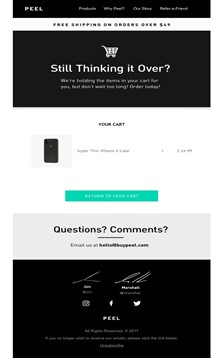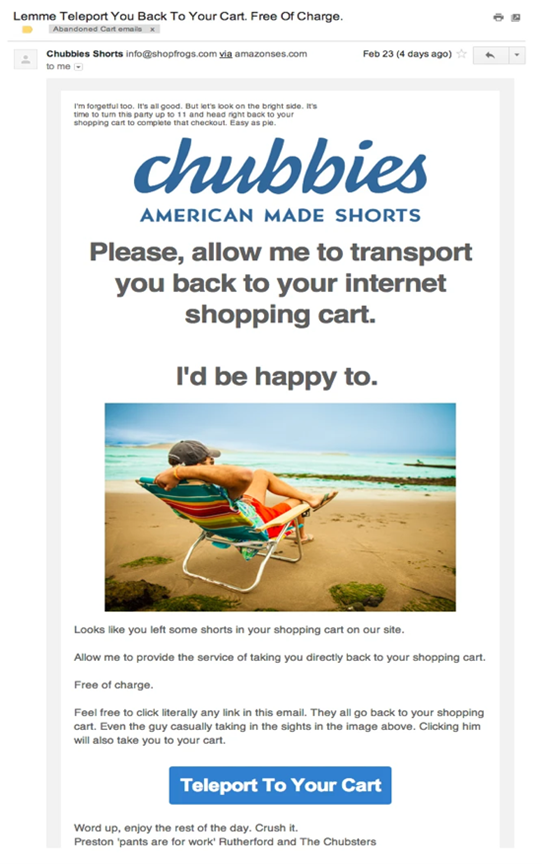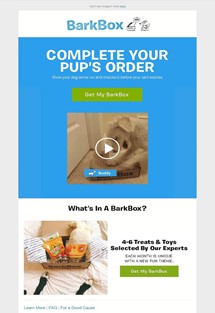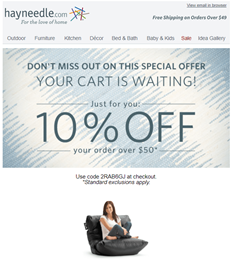We've all been there – you're browsing an online store, you put some items in your cart, and then you exit before hitting "purchase." This phenomenon is called cart abandonment, and even though it is common among all e-commerce stores, you can mitigate it with a tactful cart recovery strategy and email marketing campaign. Learn the leading causes of cart abandonment and ways to improve your marketing strategies to convert abandoned carts into online sales.
What is shopping cart abandonment?
E-commerce cart abandonment is when a customer visits an online store, adds items to their shopping cart, and then decides to leave the website before completing the purchase. There are several reasons why a customer might abandon their online shopping cart, many of which can be resolved through strategic email marketing.
"While e-commerce cart abandonment doesn't typically hold a positive connotation, it is overwhelmingly an opportunity for a brand to showcase their value to a customer, to make a sale and to drive long-term loyalty," Garin Hobbs, SVP of client strategy and evangelism at Zembula, told business.com. "Most customers expect a generic 'Hey [first name], you left some items in your cart!' email, but an agile, intuitive e-commerce brand will use this opportunity to connect with potential customers on a deeper level."
Editor's note: Looking for the right email marketing service for your business? Fill out the questionnaire below to have our vendor partners contact you about your needs.
Why do customers abandon their online shopping carts?
When digital shoppers were asked why they abandoned their online shopping carts, the primary reason was the cost of shipping (63%), followed by discount codes that don't work (46%) and long shipping times (36%).
Many cart abandonment issues are easy to resolve. If a customer is failing to complete a purchase for any reason other than not wanting the item, there is a good chance you can solve their problem and increase your conversion rates. If you learn why customers may be abandoning their shopping carts, you can anticipate a way to fix that.
Here are other common reasons customers abandon their carts:
- No discounts are available.
- You do not offer express shipping.
- They have to reenter their credit card information.
- Not enough payment methods are available.
- They have concerns about online payment security.
- You require them to create an account before making a purchase.
- The checkout process is too long and complicated.
- You have an undesirable or ambiguous return/refund policy.
- You have poor customer support.
- Your website or mobile app performs poorly (e.g., it loads slowly, crashes or has errors).
- You have limited product quantity.
- They were just browsing, researching or comparison shopping for a later purchase.
Small business owners should be aware of consumers' intentions, because the modern shopper is smart and discerning. Hobbs said customers approach the e-commerce environment with intent and scrutiny, and they know that companies traditionally send cart abandonment emails with discount offers.
"Marketers can recognize this level of intentional cart abandonment as gamification," Hobbs said. "It's difficult to combat, but with the right martech (marketing and technology) stack in place, tracking these intentional abandoners is the solution. In any case, this is a classic commandment moment: Know thy customer. Then you can determine how to act."
Average cart abandonment rates
Shopping cart abandonment rates vary by industry, but they typically average between 70% and 80%. Mobile shopping cart abandonment rates are even higher, averaging around 85%. Despite a significant number of people abandoning their online shopping carts, the overall conversion rates for online shopping have been improving over the years.

How do you calculate your cart abandonment rates?
To improve your e-commerce conversion rates, you should start by calculating your current cart abandonment rate. You can do this with a simple equation: Divide the number of completed transactions by the number of created shopping carts, subtract the result from 1, then multiply by 100. Make sure all transactions and shopping cart numbers in the equation are from the same time period.
For example, if a company has 3,000 completed transactions in one month and 10,000 total shopping carts created in that same month, what is the shopping cart abandonment rate?
Step 1: 3,000 completed transactions ÷ 10,000 shopping carts = 0.3
Step 2: 1 - 0.3 = 0.7
Step 3: 0.7 x 100 = 70%
In this example, the shopping cart abandonment rate would be 70%.
How do you recover abandoned carts with email marketing?
Instead of viewing abandoned carts as lost sales, think of them as opportunities. Just because a customer leaves your site doesn't mean you should stop communicating with them. One of the best ways to win over a potential customer who previously abandoned their e-commerce cart is through strategic email marketing.
Recent surveys show that 45% of all cart abandonment emails are opened. Additionally, the average abandoned cart email click-through rate is 21%, and the abandoned cart email conversion rate is roughly 10% (although rates vary by industry, device and recovery tactics). This gives you a great opportunity to create savvy and timely cart abandonment emails that resonate with your audience and increase conversions.
Hobbs suggested this process to improve your cart abandonment email campaigns:
1. Show the customer what they are missing.
Replicate the abandoned cart in the email, showing the exact items the shopper left behind. Visually depict what they're missing out on by abandoning their cart. Emotion is often at play in retail purchases, so use that to your advantage.
You can also display similar in-stock items at lower price points and/or with faster shipping. Give customers the chance to add reliable and attractive replacement options to their cart.
2. Offer discounts and incentives.
When you analyze your cart abandoners, segment those repeat gamifiers (customers who have a history of abandoning their cart and then converting when you offer a competitive coupon). Once you identify these customers, make sure to send them modest coupons. Recognize their value, appeal to their money-saving tactics, and make the sale.
When sending discounts and options to customers, remember to A/B test different messages, offers and calls to action (CTAs) in real time to determine what resonates with each consumer, down to which color of the button generates more engagement. Perform these tests for any campaign you run and at multiple intervals during the year. As customers change their preferences, update your marketing strategy.
3. Close the shipping gap.
With companies like Amazon offering free one-day shipping, consumers expect the same from every brand. If a customer is concerned with shipping costs, offer discounted or free shipping once they reach a certain cart spend. This will not only incentivize greater spending, but also show that your brand can compete with the conglomerates.
Another option to close the shipping gap is to offer cheaper or faster shipping alternatives, such as curbside or in-store pickup, in your follow-up email.
4. Simplify the purchasing process.
Offer single-click, in-email purchase completion capabilities to facilitate a faster purchase. Synchronize messaging across email, mobile and web channels to create a re-engagement ecosystem and a layered messaging scheme. This reactive workflow will let you message customers based on a series of anticipated user behaviors.
"With the right optimization of timing, frequency, cadence, channel, and personalized content, offers and context, abandoned cart email performance can be improved up to an industry-standard recovery rate," Hobbs said.
How do you create your own abandoned cart email sequence?
There are several great email marketing services that can integrate with your e-commerce store and generate automated abandoned cart email sequences based on customer behavior. Since every business is different, the best email sequence (e.g., three, five or six emails) for your audience depends on your customers and their specific needs.
Hobbs offered a five-step approach to get you started on your abandoned shopping cart campaign:
- Send the first message in as close to real time as possible. Purchase considerations are often fleeting, and the greatest opportunity to convert is that moment when customer intent is highest.
- Personalize the content to show the exact abandoned item or categorically similar product recommendations.
- Offer a discount to close the deal. This can be either a percentage discount or free shipping.
- Message with empathy, value and brand authenticity.
- Test your email sequences often.
"In addition to trying to recover abandoned carts, it is also in the best interest of the site to determine why customers are abandoning their carts in the first place," said Harry Thakkar, partner at Avatria. "While it won't be possible to eliminate all abandoned carts, any underlying causes leading to an increase in abandoned carts needs to be addressed as a priority."
Why should you send an automated series of abandoned cart emails?
Research shows that sending a series of three abandoned cart recovery emails can result in 69% more completed transactions than a single email would. A series of automated abandoned cart emails can bring your customers back into your funnel and drive revenue that would have otherwise been lost.
"It's like the saying goes: Why go an inch when you can go a mile, right?" Hobbs said. "Why send a single email when you can send a series of automated and strategic, layered messages? One email won't convert all abandoners – though they nearly always have the highest open rates, click-through rates, and conversion rates due to the immediacy of their delivery."
In addition to increasing conversions and recovering lost revenue, sending automated abandoned cart emails that are personalized to each recipient will show that you understand your customers' needs. This can create loyal customers and build brand reputation.

Abandoned cart email examples
Here are several examples of abandoned cart emails. Each company in these examples used a blend of strategies to win back customers and complete the purchase.
Peel
An abandoned cart email sent by the company Peel incentivized customers with free shipping. The email had a minimalist design with the phrase "Free shipping on orders over $49" across the top of the email. Additionally, the company used a sense of urgency to encourage customers to make an immediate purchase. It said, "Still thinking it over? We're holding the items in your cart for you, but don't wait too long! Order today!"

Chubbies
Chubbies offered another example of a compelling abandoned cart email. The company used humor and fun to appeal to customers, alongside eye-catching visuals.
The email we evaluated displayed a man relaxing on the beach. Beneath the image, the company appealed to the lighthearted nature of its clientele by adding, "Looks like you left some shorts in your shopping cart on our site. Allow me to provide the service of taking you directly back to your shopping cart. Free of charge. Feel free to click literally any link in this email. They all go back to your shopping cart. Even the guy casually taking in the sights in the image above. Clicking him will also take you to your cart."
The email had a large CTA that said, "Teleport to your cart," clearly expressing what the next step was. Another positive aspect of the email is that it contained multiple links to bring customers right back to their carts to complete their purchase.

BarkBox
BarkBox used mixed media in its abandoned shopping cart email to draw in new customers. The top half of the email said, "Complete your pup's order," with a CTA that read, "Get my BarkBox." To supplement the text, the email included a short video of a dog enjoying BarkBox products. This visual helps customers imagine how BarkBox integrates with their own pet's life.
The second half of the email is minimalistic, but it lists (in text and images) the type of products a new client can expect. The text is easy to read, and the link to complete the purchase is front and center.

Hayneedle
Including a discount with your email reminding customers they have an abandoned cart is a popular strategy. Discount emails are limited-time offers intended to create a sense of urgency so the customer completes the purchase. Most discount offers for abandoned carts are modest, with an average discount of 10%. Hayneedle offered a discount like this in one of its abandoned cart emails.
The email we analyzed said, "Don't miss out on this special offer. Your cart is waiting! Just for you: 10% off your order over $50!"
Along with the sense of urgency, the email uses exclusive language that makes the reader feel special. It also uses an order minimum of $50 to encourage the customer to spend more money.

Additional tips for reducing cart abandonment
Shopping cart abandonment emails can be an effective way to bring customers back into the funnel, but what if there were a way to keep your customer from leaving your online store in the first place? You can take several steps to minimize friction on your e-commerce site and reduce cart abandonment.
From a technical standpoint, your online shop should be intuitive, fast-loading, easy to navigate and optimized for mobile devices. Use product images to keep customers in the purchasing process, and consider adding a progress bar so they can see how close they are to finalizing their purchase.
If your customer has made it all the way through the purchasing funnel and is about to pay for their items, there is more you can do to get them to hit "confirm purchase." First, gain their trust. Place trust signals, like security logos and money-back guarantees, close to your transaction forms.
Additionally, allowing guest checkout and multiple payment options simplifies the checkout process for many consumers.
Some source interviews were conducted for a previous version of this article.
